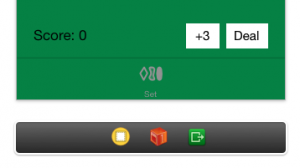Please note, this blog entry is from a previous course. You might want to check out the current one.
As in a real game of Set, the user should start with 12 cards and then have the option of requesting 3 more cards to be dealt at any time if he or she is unable to locate a Set. Do something sensible when there are no more cards in the deck.
Add a new button in storyboard and set its tag to 3 (the number of cards that should be added):

Continue reading “cs193p – Assignment #4 Task #4”
